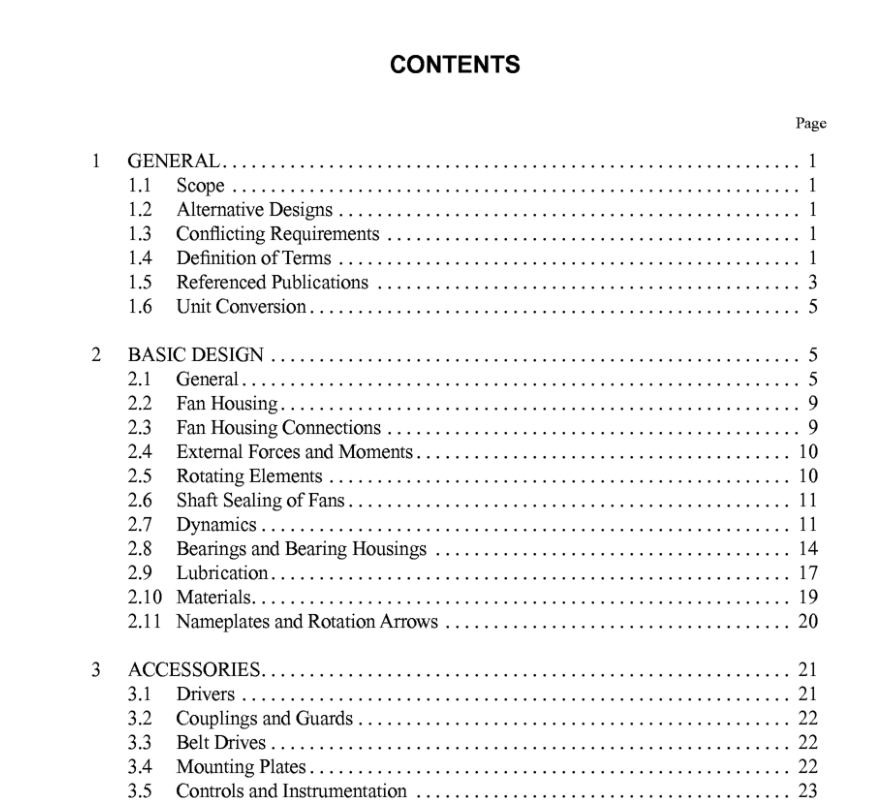API Std 673 pdf download

API Std 673 pdf download.Centrifugal Fans for Petroleum, Chemical and Gas Industry Services
1 General
1.1 SCOPE This standard covers the minimum requirements for cen- trifugal fans intended for continuous duty in petroleum, chemical, and gas industry services. Fan pressure rise is lim- ited to differential from a single impeller, usually not exceed- ing 100 in. of water Equivalent Air Pressure (EAP). Cooling tower, aerial cooler, and ventilation fans; and positive dis- placement blowers are NOT covered by this standard. Note: A bullet (0) at the beginning of a paragraph indicates that either a decision is required or further information is to be provided by the purchaser. This information should be indicated on the data sheets (see Appendix A); otherwise, it should be stated in the quota- tion request or in the order. 1.2 ALTERNATIVE DESIGNS The vendor may offer alternative designs. Equivalent met- ric dimensions, fasteners, and flanges may be substituted as mutually agreed upon by the purchaser and the vendor (see 5.2.3.g). 1.3 CONFLICTING REQUIREMENTS In case of conñict between this standard and the inquiry or order, the information included in the order shall govern. 1.4 DEFINITION OF TERMS Terms used in this standard are defined in 1.4.1 through 1.4.33. 1.4.1 alarm point: A preset value of a parameter at which an alarm is actuated to warn of a condition that requires cor- rective action. 1.4.2 axially split: Refers to casing joints that are parallel to the shaft centerline. 1.4.3 design: The use of the word design in any term (such as design power, design pressure, design temperature, or design speed) should be avoided in the purchaser’s specifi- cations. This terminology should only be used by the equip- ment designer and the manufacturer. 1.4.4 evase: A diffuser or a diverging discharge transition piece. 1.4.5 fan impeller: The assembly of the fan wheel and the hub@). 1.4.6 fan plane: A flow area perpendicular to the flow of gas at the specified reference plane; that is, inlet flange or out- let flange.1.4.7 fan rated point: Defined as (1) the highest speed necessary to meet any specified operating condition, and (2) the rated capacity required by fan designs to meet all speci- fied operating points. (The vendor shall select this capacity point to best encompass specified operating conditions within the scope of the expected performance curve.) (See Figure 1 .) Note: This term is NOT to be confused with the AMCA Publication 802 definition of RATING point, which more nearly matches “nor- mal point” per 1.4.21. User must add head andor volume margins for process uncertainties, reduced performance resulting from time related “wear and tear” and other operating conditions known to exist. The API “Rated” point will be the same as the AMCA defined “MCR Test Block” (para. 3.1.13, AMCA 801-92) condition unless otherwise defined by the user in specifications or data sheets. For most applications this will coincide with “Test Block” (para. 3.1.14, 1.4.8 fan rotor: The assembly of the fan impeller and the shaft. 1.4.9 fan wheel: The assembly comprised of the blades, center-plate (or back-plate), shroud(& and wear plates, if used. AMCA 801-92). 1.4.1 O forced-draft fans: Usually have ambient inlet conditions and usually are in air service. 1.4.1 1 hydrodynamic bearings: Bearings that use the principles of hydrodynamic lubrication. Their surfaces are oriented so that relative motion forms an oil wedge to support the load without journal-to-bearing contact. 1.4.12 induced draft fans: Usually have inlet condition that are below atmospheric pressure and can be found in a wide variety of gas services. Process fans, by definition, are induced draft.









